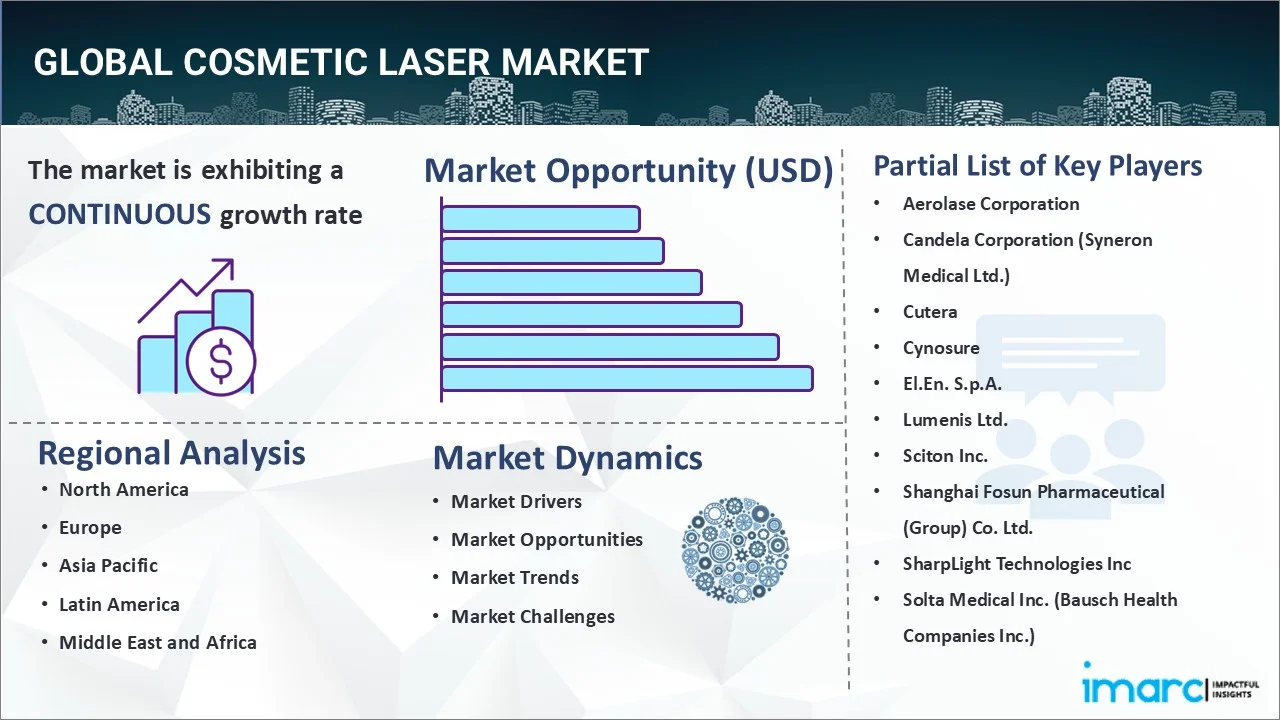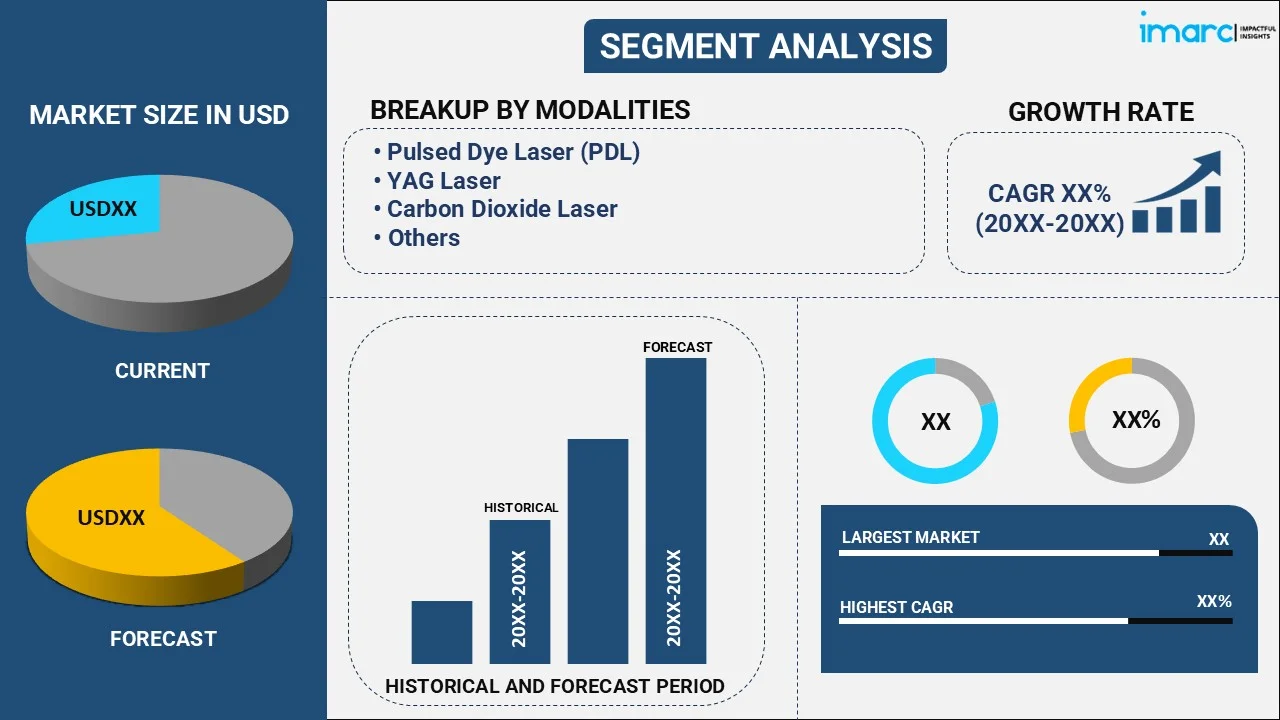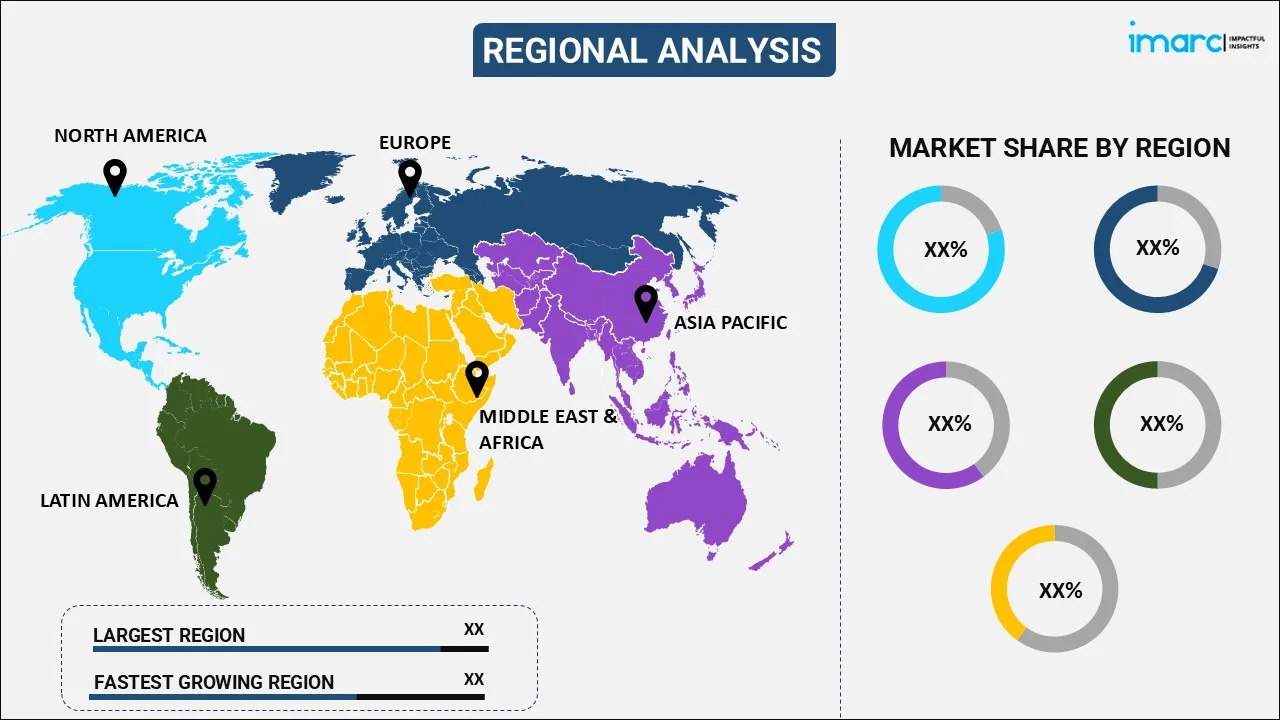
Cosmetic Laser Market Report by Modality (Pulsed Dye Laser (PDL), YAG Laser, Carbon Dioxide Laser, Erbium, Intense Pulsed Light (IPL), Radiofrequency, Infrared, and Others), Product (Ablative, Non-Ablative), Application (Hair Removal, Skin Resurfacing, Vascular Lesions, Scar and Acne Removal, Body Contouring, and Others), End User (Hospitals, Skin Care Clinics, Cosmetics Surgical Centres), and Region 2025-2033
Market Overview:
The global cosmetic laser market size reached USD 2.7 Billion in 2024. Looking forward, IMARC Group expects the market to reach USD 7.0 Billion by 2033, exhibiting a growth rate (CAGR) of 10.34% during 2025-2033.
|
Report Attribute
|
Key Statistics
|
|---|---|
|
Base Year
|
2024
|
|
Forecast Years
|
2025-2033
|
|
Historical Years
|
2019-2024
|
|
Market Size in 2024
|
USD 2.7 Billion |
|
Market Forecast in 2033
|
USD 7.0 Billion |
| Market Growth Rate 2025-2033 | 10.34% |
A cosmetic laser is used in surgical procedures to remove hair, tattoos, scars, sunspots, wrinkles, birthmarks, stretch marks, and spider veins. It relies on precisely focused light sources to treat skin conditions, such as skin resurfacing, hair removal, and improving the appearance of scars, lines, wrinkles, and acne. It offers the advantages of decreased postoperative discomfort, reduced blood loss, minimized risk of wound infection, and better wound healing. Presently, there is a rise in the utilization of newly introduced carbon dioxide (CO2) technology, which aids in deep collagen stimulation and superficial tightening and pigment reduction.

Cosmetic Laser Market Trends:
Rising beauty consciousness among individuals, in confluence with the increasing influence of social media, rapid urbanization, and inflating per capita income, represents one of the key factors catalyzing the demand for cosmetic lasers worldwide. In addition to this, a significant rise in the aging population across the globe, along with the increasing focus on maintaining a youthful appearance, is contributing to market growth. Apart from this, the emerging trend of cosmetic tourism and minimally invasive surgeries (MIS) is influencing the market positively. Moreover, as excessive sun exposure leads to various skin conditions, the demand for cosmetic lasers is escalating among individuals. The growing prevalence of obesity is also propelling the adoption of body contouring devices to tighten lax skin and remove undesired fat from various parts of the body. Furthermore, the introduction of advanced light-based technologies, such as infrared, radiofrequency, intense pulsed light (IPL), and light-emitting diode (LED), is driving the market. The leading manufacturers are also offering hand-held, over-the-counter (OTC) cosmetic laser and light devices for home use, which is creating a positive market outlook.
Key Market Segmentation:
IMARC Group provides an analysis of the key trends in each sub-segment of the global cosmetic laser market report, along with forecasts at the global, regional and country level from 2025-2033. Our report has categorized the market based on modality, product, application and end user.
Breakup by Modality:

- Pulsed Dye Laser (PDL)
- YAG Laser
- Carbon Dioxide Laser
- Erbium
- Intense Pulsed Light (IPL)
- Radiofrequency
- Infrared
- Others
Breakup by Product:
- Ablative
- Non-Ablative
Breakup by Application:
- Hair Removal
- Skin Resurfacing
- Vascular Lesions
- Scar and Acne Removal
- Body Contouring
- Others
Breakup by End User:
- Hospitals
- Skin Care Clinics
- Cosmetics Surgical Centres
Breakup by Region:

- North America
- United States
- Canada
- Asia-Pacific
- China
- Japan
- India
- South Korea
- Australia
- Indonesia
- Others
- Europe
- Germany
- France
- United Kingdom
- Italy
- Spain
- Russia
- Others
- Latin America
- Brazil
- Mexico
- Others
- Middle East and Africa
Competitive Landscape:
The competitive landscape of the industry has also been examined along with the profiles of the key players being Aerolase Corporation, Candela Corporation (Syneron Medical Ltd.), Cutera, Cynosure, El.En. S.p.A., Lumenis Ltd., Sciton Inc., Shanghai Fosun Pharmaceutical (Group) Co. Ltd., SharpLight Technologies Inc and Solta Medical Inc. (Bausch Health Companies Inc.).
Report Coverage:
| Report Features | Details |
|---|---|
| Base Year of the Analysis | 2024 |
| Historical Period | 2019-2024 |
| Forecast Period | 2025-2033 |
| Units | Billion USD |
| Segment Coverage | Modality, Product, Application, End User, Region |
| Region Covered | Asia Pacific, Europe, North America, Latin America, Middle East and Africa |
| Countries Covered | United States, Canada, Germany, France, United Kingdom, Italy, Spain, Russia, China, Japan, India, South Korea, Australia, Indonesia, Brazil, Mexico |
| Companies Covered | Aerolase Corporation, Candela Corporation (Syneron Medical Ltd.), Cutera, Cynosure, El.En. S.p.A., Lumenis Ltd., Sciton Inc., Shanghai Fosun Pharmaceutical (Group) Co. Ltd., SharpLight Technologies Inc, Solta Medical Inc. (Bausch Health Companies Inc.) |
| Customization Scope | 10% Free Customization |
| Post-Sale Analyst Support | 10-12 Weeks |
| Delivery Format | PDF and Excel through Email (We can also provide the editable version of the report in PPT/Word format on special request) |
Key Questions Answered in This Report
The global cosmetic laser market was valued at USD 2.7 Billion in 2024.
We expect the global cosmetic laser market to exhibit a CAGR of 10.34% during 2025-2033.
The rising adoption of cosmetic laser treatments owing to growing consciousness towards physical appearance, along with the introduction of minimally-invasive procedures, is primarily driving the global cosmetic laser market.
The sudden outbreak of the COVID-19 pandemic had led to the postponement of elective cosmetic laser surgical procedures to reduce the risk of the coronavirus infection upon hospital visits and interaction with healthcare professionals or medical equipment.
Based on the modality, the global cosmetic laser market has been divided into Pulsed Dye Laser (PDL), YAG laser, carbon dioxide laser, erbium, Intense Pulsed Light (IPL), radiofrequency, infrared, and others. Among these, Pulsed Dye Laser (PDL) currently exhibits a clear dominance in the market.
Based on the product, the global cosmetic laser market can be categorized into ablative and non-ablative. Currently, non-ablative accounts for the majority of the global market share.
Based on the application, the global cosmetic laser market has been segregated into hair removal, skin resurfacing, vascular lesions, scar and acne removal, body contouring, and others, where body contouring currently holds the largest market share.
Based on the end user, the global cosmetic laser market can be bifurcated into hospitals, skin care clinics, and cosmetics surgical centers. Currently, skin care clinics exhibit a clear dominance in the market.
On a regional level, the market has been classified into North America, Asia-Pacific, Europe, Latin America, and Middle East and Africa, where North America currently dominates the global market.
Some of the major players in the global cosmetic laser market include Aerolase Corporation, Candela Corporation (Syneron Medical Ltd.), Cutera, Cynosure, El.En. S.p.A., Lumenis Ltd., Sciton Inc., Shanghai Fosun Pharmaceutical (Group) Co. Ltd., SharpLight Technologies Inc, and Solta Medical Inc. (Bausch Health Companies Inc.).
Need more help?
- Speak to our experienced analysts for insights on the current market scenarios.
- Include additional segments and countries to customize the report as per your requirement.
- Gain an unparalleled competitive advantage in your domain by understanding how to utilize the report and positively impacting your operations and revenue.
- For further assistance, please connect with our analysts.
 Inquire Before Buying
Inquire Before Buying
 Speak to an Analyst
Speak to an Analyst
 Request Brochure
Request Brochure
 Request Customization
Request Customization




.webp)




.webp)












